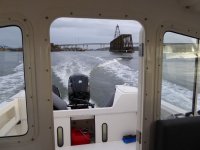I am putting a new fuel tanks in my 22' cruiser and I would like some suggestions as to how to proceed.
The obvious simple answer is to buy a pair of Muelleur tanks but I have looked into that and they will take several weeks to come. I should have ordered them in the fall, but I didn't so now I want to look at all my options.
Custom tanks may be a little more expensive but I could be on the water much sooner - although I may still decide to order the 23 gallon Muelleur tanks and wait for them to arrive. However, this seems like a good time to upgrade to slightly larger tanks.
At present my boat does not have any fuel tanks because just over a year ago someone decided they wanted them more than I did and both of my tanks disappeared one night and I haven't used the boat since - but now I want to get back out onto the water.
I have twin hondas and would like to have two tanks so each motor has a different gas tank.
My questions are:
What are the advantages/disadvantages of aluminum tanks?
What are the advantages/disadvantages of plastic tanks?
What are the advantages/disadvantages of saddle tanks? Do they fit in well and does anyone have measurements that worked for them?
Do you have any tidbits of advice that save me from making costly or stupid mistakes.
I will have to hire someone to do all the work so I know this will be an expensive undertaking. All the lines, brackets and hoses will have to be replaced as they were all destroyed during the removal of the original tanks.
Any and all suggestions are gratefully appreciated.
The obvious simple answer is to buy a pair of Muelleur tanks but I have looked into that and they will take several weeks to come. I should have ordered them in the fall, but I didn't so now I want to look at all my options.
Custom tanks may be a little more expensive but I could be on the water much sooner - although I may still decide to order the 23 gallon Muelleur tanks and wait for them to arrive. However, this seems like a good time to upgrade to slightly larger tanks.
At present my boat does not have any fuel tanks because just over a year ago someone decided they wanted them more than I did and both of my tanks disappeared one night and I haven't used the boat since - but now I want to get back out onto the water.
I have twin hondas and would like to have two tanks so each motor has a different gas tank.
My questions are:
What are the advantages/disadvantages of aluminum tanks?
What are the advantages/disadvantages of plastic tanks?
What are the advantages/disadvantages of saddle tanks? Do they fit in well and does anyone have measurements that worked for them?
Do you have any tidbits of advice that save me from making costly or stupid mistakes.
I will have to hire someone to do all the work so I know this will be an expensive undertaking. All the lines, brackets and hoses will have to be replaced as they were all destroyed during the removal of the original tanks.
Any and all suggestions are gratefully appreciated.




